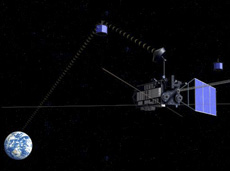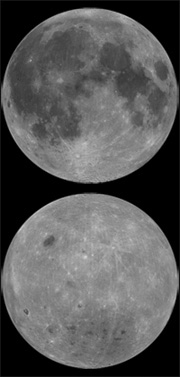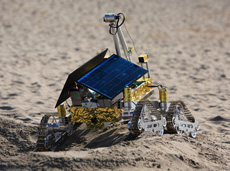
Q. Could you tell us about the relationship between the National Astronomical Observatory of Japan (NAOJ) and the lunar explorer KAGUYA?

Lunar topographic map made with observation data acquired by the laser altimeter

KAGUYA used a relay satellite to observe lunar gravitational fields
NAOJ launched the RISE (Research In Selenodesy) Project as a part of the KAGUYA (AKA SELENE) project. With the aim of investigating the lunar gravity field and topography, we developed three scientific instruments - the laser altimeter (LALT), the relay satellite, and the VLBI radio source (VRAD satellite) - in collaboration with JAXA and universities across Japan.
A topographic map of the Earth is created based on photographic data. KAGUYA, on the other hand, obtains altitude data of the Moon's topography by measuring its main orbiter's altitude. KAGUYA sends a laser beam down to the lunar surface, and calculates the distance by measuring the timing delay of the reflected light. At the same time, we obtain orbital information - i.e. the location and position of the main orbiter - by tracking it from the Earth or by using its own onboard sensors. By combining the orbital and altitude information of the main orbiter, we can determine the topographic highs and lows of the Moon. KAGUYA orbits the Moon in polar orbit, meaning it passes above both the North and South poles, so it can observe the entire Moon as it rotates. This is allowing us to obtain a global topographic map of the Moon, including its polar regions, with the greatest accuracy ever achieved.
The velocity of a lunar orbiter changes depending on the lunar gravity field - it moves faster when gravity is stronger, and slower when gravity is weaker. So you can measure the lunar gravity field by tracking the movement of the orbiter via radio waves. But because the Moon always shows one side - what we call the nearside - to the Earth, we cannot track the explorer when it goes to the lunar farside. Data acquisition becomes impossible. Our solution is to track KAGUYA on the farside using relay satellites, making precise measurement of lunar gravity on the farside possible for the first time. In addition, to get more accurate measurements of the gravity field, KAGUYA applies a geodetic technique used in radio astronomy, called VLBI (Very Long Baseline Interferometry), for precise determination of locations of three satellites of KAGUYA. For KAGUYA's VLBI observations, we use an international radio telescope network involving China, Germany and Australia, as well as the domestic network of NAOJ.
Like on the Earth, gravity on the Moon changes according to the surface topography: gravity is stronger over mountains and weaker over depressions. Also, gravity changes depending on the density of the interior; it is stronger where there are heavy subsurface materials. So measuring lunar gravity helps us understand the interior structure of the Moon, which cannot be studied just by looking at the surface. NAOJ hopes to explain the topography and interior structure of the Moon in order to learn more about its origin and evolution.
A topographic map of the Earth is created based on photographic data. KAGUYA, on the other hand, obtains altitude data of the Moon's topography by measuring its main orbiter's altitude. KAGUYA sends a laser beam down to the lunar surface, and calculates the distance by measuring the timing delay of the reflected light. At the same time, we obtain orbital information - i.e. the location and position of the main orbiter - by tracking it from the Earth or by using its own onboard sensors. By combining the orbital and altitude information of the main orbiter, we can determine the topographic highs and lows of the Moon. KAGUYA orbits the Moon in polar orbit, meaning it passes above both the North and South poles, so it can observe the entire Moon as it rotates. This is allowing us to obtain a global topographic map of the Moon, including its polar regions, with the greatest accuracy ever achieved.
The velocity of a lunar orbiter changes depending on the lunar gravity field - it moves faster when gravity is stronger, and slower when gravity is weaker. So you can measure the lunar gravity field by tracking the movement of the orbiter via radio waves. But because the Moon always shows one side - what we call the nearside - to the Earth, we cannot track the explorer when it goes to the lunar farside. Data acquisition becomes impossible. Our solution is to track KAGUYA on the farside using relay satellites, making precise measurement of lunar gravity on the farside possible for the first time. In addition, to get more accurate measurements of the gravity field, KAGUYA applies a geodetic technique used in radio astronomy, called VLBI (Very Long Baseline Interferometry), for precise determination of locations of three satellites of KAGUYA. For KAGUYA's VLBI observations, we use an international radio telescope network involving China, Germany and Australia, as well as the domestic network of NAOJ.
Like on the Earth, gravity on the Moon changes according to the surface topography: gravity is stronger over mountains and weaker over depressions. Also, gravity changes depending on the density of the interior; it is stronger where there are heavy subsurface materials. So measuring lunar gravity helps us understand the interior structure of the Moon, which cannot be studied just by looking at the surface. NAOJ hopes to explain the topography and interior structure of the Moon in order to learn more about its origin and evolution.

Lunar nearside (above) and farside (below) (courtesy: NASA)
Q. What aspects of lunar research in particular are you interested in?
I would like to explore the differences between the lunar nearside and farside. In 1959, the lunar farside was photographed for the first time by the Soviet Luna 3 probe, and it revealed that there are fewer lunar maria (i.e. plains formed when giant craters are filled with lava) on the farside. Why is this? How did it come about? Fifty years later, we still don't know the answers. I am very interested in the different evolution processes of the lunar nearside and farside, as well as their different appearances.
Q. NAOJ has simulated the formation of the Moon. Have KAGUYA's observations brought any new insights to conventional theories?
NAOJ's simulation posits that a Mars-sized celestial body impacted the Earth, forming a disk around it, which then coalesced to form the Moon. Materials gathered so quickly that the Moon is thought to have been extremely hot at its birth. KAGUYA is providing observation data to support a theory of lunar origin that says the surface crust was made with hot, melted materials. But then, why is the crust thickness different on the near side and far side? Why did the two sides develop differently? As KAGUYA's data are analyzed, I expect that we will find out whether or not our scenario of lunar formation is correct.
I would like to explore the differences between the lunar nearside and farside. In 1959, the lunar farside was photographed for the first time by the Soviet Luna 3 probe, and it revealed that there are fewer lunar maria (i.e. plains formed when giant craters are filled with lava) on the farside. Why is this? How did it come about? Fifty years later, we still don't know the answers. I am very interested in the different evolution processes of the lunar nearside and farside, as well as their different appearances.
Q. NAOJ has simulated the formation of the Moon. Have KAGUYA's observations brought any new insights to conventional theories?
NAOJ's simulation posits that a Mars-sized celestial body impacted the Earth, forming a disk around it, which then coalesced to form the Moon. Materials gathered so quickly that the Moon is thought to have been extremely hot at its birth. KAGUYA is providing observation data to support a theory of lunar origin that says the surface crust was made with hot, melted materials. But then, why is the crust thickness different on the near side and far side? Why did the two sides develop differently? As KAGUYA's data are analyzed, I expect that we will find out whether or not our scenario of lunar formation is correct.
Q. Why do you think humans aspire to explore the Moon?

Vicinity of Mare Moscoviense, imaged by KAGUYA's high-definition camera
I think it is because the Moon is our closest and most familiar celestial body. Naturally, I think that humans will go to explore Mars and other bodies in the future, but the Moon is the most familiar target to us in terms of space exploration because humans have already been there. Also, from the point of view of science, even though the formation of the Moon and the Earth are believed to have occurred at almost the same time, today the Earth has few rocks as old as the ones on the Moon. So studying the Moon is also very important for a better understanding of the history of the Earth. The Moon tells us about our own planet. Finally, I think that our strong interest in exploration is another reason the Moon attracts us so much.
Q. What sort of outcomes do you expect from KAGUYA?
Analysis of KAGUYA's data has just begun. I am looking forward to receiving observation results of the lunar crust because they will give us ideas about the its composition and thickness in different areas - in other words, whether or not the crust is the same all over the Moon's surface. Also, there are many models to explain crust formation, such as: a) the crust formed the same way on the entire globe; b) the core of the crust formed first and then developed gradually; c) crusts formed separately and then merged. We will be able to find which one is correct by analyzing a lot of data. To do so, it is very important to combine data obtained not just with one instrument but with many different ones.
Q. What are your hopes for future lunar exploration?

JAXA's lunar rover in development (prototype)
The KAGUYA project's planned observations are almost complete, but there are still many things I would like to investigate.
KAGUYA is mapping the Moon by orbiting it, but I would like to land an explorer on the surface to enhance lunar research. NAOJ is planning to look at the interior structure of the lunar core and lower mantle by using a lander to measure the velocity change of the lunar rotation. Also, there are things that you can understand only by directly looking at the surface materials, so I would like to observe the lunar surface and interior using a lander and a rover, and someday return samples from the lunar far side. I think such lunar exploration will also provide a model for future exploration of celestial bodies in the solar system at greater distances.
KAGUYA is mapping the Moon by orbiting it, but I would like to land an explorer on the surface to enhance lunar research. NAOJ is planning to look at the interior structure of the lunar core and lower mantle by using a lander to measure the velocity change of the lunar rotation. Also, there are things that you can understand only by directly looking at the surface materials, so I would like to observe the lunar surface and interior using a lander and a rover, and someday return samples from the lunar far side. I think such lunar exploration will also provide a model for future exploration of celestial bodies in the solar system at greater distances.
Sho Sakaki
Professor, National Astronomical Observatory of Japan (NAOJ)
RISE (Research in Selenodesy) Project Manager
Dr. Sakaki received his Ph.D. in 1987 from the School of Science at the University of Tokyo. Before assuming his current position, he served as researcher for the Lunar and Planetary Laboratory at the University of Arizona, research associate at the Faculty of Science at Hiroshima University, and associate professor of the Department of Earth and Planetary Science at the Graduate School of Science, University of Tokyo.
Professor, National Astronomical Observatory of Japan (NAOJ)
RISE (Research in Selenodesy) Project Manager
Dr. Sakaki received his Ph.D. in 1987 from the School of Science at the University of Tokyo. Before assuming his current position, he served as researcher for the Lunar and Planetary Laboratory at the University of Arizona, research associate at the Faculty of Science at Hiroshima University, and associate professor of the Department of Earth and Planetary Science at the Graduate School of Science, University of Tokyo.
KAGUYA's Major Scientific Results So Far
KAGUYA: Probing Lunar Science
The First Global Stereo-Imaging of the Moon
Studying the Gravity and Topography of the Moon
A New Era of Lunar Exploration
KAGUYA: Probing Lunar Science
The First Global Stereo-Imaging of the Moon
Studying the Gravity and Topography of the Moon
A New Era of Lunar Exploration